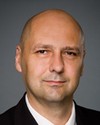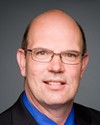I'd like to talk on that, too, madam. I'll talk about what you asked me about.
In my case, I was a physicist who worked in a hospital. Radiation delivery systems need to be managed by physicists. The technology we developed was really related to a direct observation within the clinic of a problem, and detailed insight into what was feasible. We could make this technology, but if you increase the treatment time by more than five or 10 minutes, it would not be accepted economically. It would destroy the economics of radiotherapy cancer treatment. So we had to understand that.
We had to understand what technologies were available, and we had to find an industry partner who would allow us to bring those through, all the way through, to a return to market. This is where the realization on my part came, that it's clear insight into the details of the health care system that enables technologies, which in many ways are already out there, to come together to have an impact. We patented that and it was licensed and so on and so forth. It was actually produced in the U.K., and parts of it all over the world have come together. The way the global economy works now, you work with multinationals because the time it takes them to take something to market is very short compared to a start-up. We work a lot with multinationals because you can have an impact sooner.
In terms of what the federal government can do, I think it would be outstanding if we could have some kind of responsibility communicated to the provincial health care systems that they need to innovate within their care delivery process, not just do clinical trials. Let's go back to what Jeff said, let's talk about getting data beyond six weeks. Let's turn the routine follow-up visits into a mechanism by which we collect outcomes data that is months, years. That's incredibly powerful. So turn the health care system into something that's using its internal understanding, taking the service delivery and building intellectual property. That's a huge opportunity.
That's why I was concerned about the U.S. change. It's a good thing, but in 2012 they put out a paper that said, you need to do this, you need to show us the performance and we'll pay you for it. The U.S. is investing. They're putting IT systems in, they're facilitating data collection. They're turning their health care system into something that's got an economy based on innovation. We could discuss the motivations, I agree with you, but the data collection is key. We need to do that in Canada.





